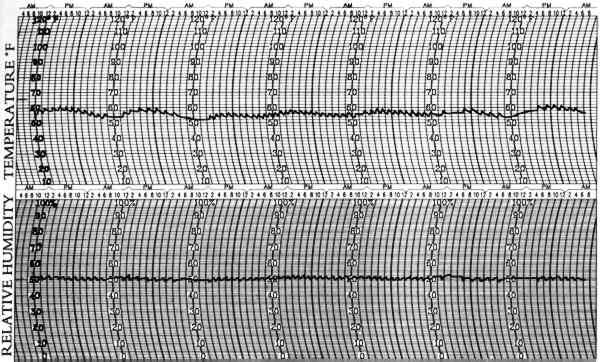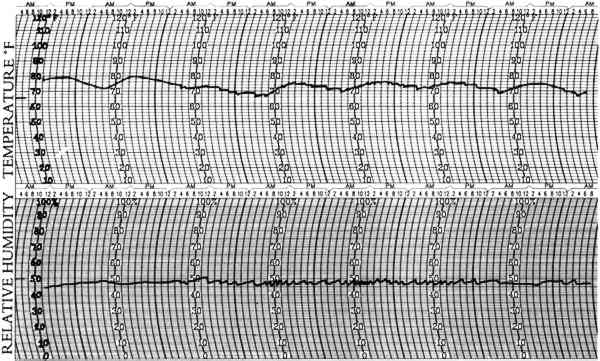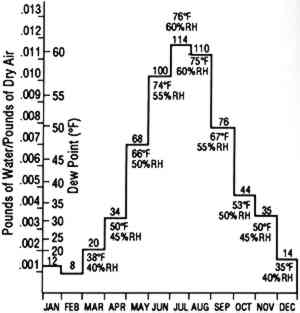A PRACTICAL APPROACH TO ENVIRONMENTAL REQUIREMENTS FOR COLLECTIONS IN HISTORIC BUILDINGSRICHARD L. KERSCHNER
4 PRACTICAL CLIMATE CONTROL ACTIONS4.1 STRIVE FOR IMPROVEMENT OF EXISTING CONDITIONSThe most important climate control action may be a change in attitude and approach. The “all or nothing ” approach to climate control must be replaced by a willingness to strive for improvement of existing environmental conditions. Using practical climate control measures, even small museums and historical societies can improve environmental conditions with modest financial commitments. The first step is to monitor temperature and humidity conditions throughout the building during the various seasons to determine actual RH and temperature levels. It is not uncommon to find RH levels of 15% and lower in buildings in northern climate regions that are heated to 60�–65�F during the winter. An RH level of 35% may seem dry when compared to an ideal level of 50%, but when compared to 15%, 35% RH is certainly desirable. Initial attempts to control the environmental conditions should be aimed at simply reducing the extremes. 4.2 REDUCE PROBLEMS AT THE SOURCEAlthough obvious, this is a sometimes ignored climate control action. The damper or dustier the environment surrounding the historic structure, the greater the “pollution pressure ” exerted on the building, and the damper or dustier the environment immediately surrounding the artifacts inside the building becomes. Large urban museums may have little control over outside dust, pollution, or ground moisture. However, the environmental assessment of Shelburne Museum indicated that there was much we could do to reduce the climate problems at the source. Many small museums and historical societies could identify problems similar to the following: 4.2.1 WaterMoisture entering collection buildings below ground level was identified as a major problem at Shelburne Museum. Damp basements can increase RH levels in the entire building. The number one recommendation resulting from the environmental assessment was to channel rain water away from the building foundations. Roof gutters and downspouts can direct the water to an expanded storm drain system that will serve all the buildings. Where gutters compromise the historic integrity of the building, a perimeter drainage system will be installed at ground level. Slope of ground around buildings will also be improved to direct water away from foundations. 4.2.2 VegetationLarge bushes and trees growing close to the houses cause moisture to be trapped in pockets between the shrubbery and the exterior wood walls. Trimming bushes back from the buildings or moving them further from the walls will allow air to circulate, keeping the walls dry. 4.2.3 DustBy analyzing the dust in our collection buildings, we were able to determine that it was a very finely divided clay from the unpaved museum roads. Dust problems can be greatly reduced by paving the road that the jitney uses to move people around the museum and the paths on which our 175,000 yearly visitors walk. Buildings with circulating air systems should contain appropriate dust filters, and air intakes for new HVAC systems should be established away from high-traffic areas, but the reduction of the dust problem at the source must be the first consideration. 4.2.4 HeatAttic areas will be insulated and ventilated to reduce heat build-up during the summer. Historic and unobtrusive window treatments will be employed to reduce light and heat penetration during the summer and keep heat in during the winter. 4.2.5 Programming and Use of BuildingsMuseum staff must carefully consider the effect that the programming and general use of museum buildings will have on the artifact environments. At Shelburne, we work with our programming staff to find creative solutions, and we are willing to compromise to improve conditions even if initially we fall short of attaining museum-wide recommended standards. For example, winter programs using artifacts in various buildings are planned so that tours through cold buildings are short, with discussions and workshops held in warmer buildings that do not house sensitive artifacts. Programs are scheduled so that the areas housing the artifacts do not have to be cycled through temperature extremes over short time periods. Winter programs using a minimally heated building are grouped so that a cold building can be slowly heated, used for a given time period, 4.3 REDUCE HEAT IN COLLECTION BUILDINGS DURING COLD WEATHERMany historic houses in the northeastern United States are closed or have limited access during the winter. Heating a building without adding moisture results in dangerously low RH levels (5% to 15%). In much of the United States and Canada, outdoor RH in the winter is above 50%. By allowing inside temperatures to drift down during the closed cold seasons, RH may remain within acceptable levels. In addition, wood structures act as humidity buffers to some degree, mitigating abrupt outdoor weather changes as they are reflected within the buildings. The following recommendations regarding temperature reduction are made. If the building is closed for the winter and it does not contain water systems, set the lower temperature limit at 35�F. Monitor the RH for a season. If the RH does not remain above 30%, allow the temperature to fluctuate with outdoor temperature with no lower limit so that an RH level of at least 30% is maintained. If the building has an operating water system that cannot be drained, reduce the temperature as low as possible without risking freezing of the pipes. If proper precautions are taken to keep water in pipes circulating, a lower temperature level of 40�F can be set. An even lower temperature can be set of the system is properly charged with antifreeze. Even if the building remains open for visitation by the public, it may be possible to reduce visitation hours and lower temperature to 50�F. The general public will be warm enough if they keep their coats on for the tour. However, the guides and security personnel who must stay in the building all day will get cold. In some historic house museums, the buildings are being heated for the comfort of the staff and to the detriment of the artifacts. Imaginative solutions to this problem can be employed. Personnel can be rotated to warmer noncollection areas on a regular schedule. Vertical radiant heaters can be employed to warm personnel but not entire rooms. Many historic house museums contain office and work areas that are used all year while the collection is open to the public on a limited schedule during the winter months. In such cases, heat only the work areas to comfort levels and keep temperatures in collection areas as low as possible to keep RH high. 4.4 INSTALL HUMIDISTATICALLY CONTROLLED HEATING IN BUILDINGS CLOSED FOR THE WINTERThis concept was first practically employed by Raymond Lafontaine (1984) of the Canadian Conservation Institute and was modified and expanded by Paul Marcon (1987). Humidistatically controlled heating attempts to limit fluctuations in RH by allowing the temperature to vary. Since changes in temperature generally result in one-tenth the dimensional movement in sensitive organic objects as do similar changes in relative humidity, if one must choose between controlling the temperature or controlling the relative humidity of the environment surrounding museum artifacts, obviously the relative humidity should be controlled. With this system of climate control, a conventional heating system is primarily controlled by a humidistat instead of a thermostat. When the humidity rises above the set point (i.e., 50% RH) during the cool seasons, the heating system At Shelburne Museum, we expanded the humidistatically controlled heating concept to include a window mounted air conditioner for summer cooling and dehumidification. Our miniature Kirk Circus consists of 4,000 carved and painted wood figures and wagons. It is displayed in a specially constructed room 30 ft long, 12 ft deep, and 8 ft high. The room is insulated, has a vapor barrier, and is tightly sealed to limit infiltration. A small wall-mounted forced-hot-air heater and a standard room air conditioner are controlled by a series of thermostats and humidistats. If the humidity is above 50% and the temperature is below 68�F, the heater is switched on to dry out the air until the RH falls to 50% (fig. 1). During the summer, if the temperature in the room is above 72�F and the RH exceeds 50%, the air conditioner is activated to dehumidify the air (fig. 2). If the temperature exceeds 78�F, the air conditioner is activated to cool the room regardless of the RH level. After two full years of operation, this system is working very well, maintaining the RH between 35% and 55% year round with gradual seasonal changes. The system cost less than $1,000 and is easy to operate and maintain. It does require weekly monitoring, seasonal adjustment, and occasional calibration of humidistats and thermostats. Close observation of the artifacts on display indicates that the climate maintained in this room is safe. No cracks or splits of the wood have been noted, paint is not cracking or flaking, and the thick resin varnish does not become hot enough to get tacky. Although not ideal, these climate conditions are certainly sufficient to preserve these artifacts well into the future.
4.5 CIRCULATE AND VENTILATE AIR FROM THE BUILDINGS IN THE SUMMER TO REDUCE HEAT AND HUMIDITY LEVELSThe environmental survey at Shelburne Museum indicated that the heat and humidity levels inside the buildings on hot summer days were often higher than the levels outside. A well-controlled, properly sized ventilation system could be used to circulate drier outside air efficiently through a building on these days, thereby improving environmental conditions inside the building. The ventilation system should be controlled by humidity or dew point sensors so that it operates only when the outside air is drier than the inside air. Since little research has been conducted using ventilation to reduce high RH within buildings, we plan to study and document the effectiveness of humidistatically controlled ventilation at Shelburne Museum during the next few years. Although practical climate control methods are meant to be simple and relatively inexpensive, it is important to use the best technology when designing these systems. The last two methods discussed—humidistatically controlled heating and ventilation—can use the latest technology in sophisticated control systems to monitor environmental conditions and operate relatively simple mechanical systems. The dependability and accuracy of newly developed sensors and controls could lead to reliable, low-maintenance systems. If old heating and cooling systems are being replaced, new fuel-efficient systems can be employed. Shelburne Museum plans to install humidistatically controlled heating and ventilating systems that are based on outdoor dew point sensing in several of its historic buildings. Historic houses with poor thermal characteristics (such as board walls, or no insulation or vapor barriers) whose interior moisture content closely follows the outdoor moisture content are good 4.6 POOR MAN'S CLIMATE CONTROLThis simplified approach to dew point control uses statistical weather data and a clock device or person to reset room temperatures to match outdoor dew point based on local historical weather data (Conrad 1990). The graph in figure 3 presents data based on a manual procedure of setting a thermostat to maintain the RH between 40% and 60�% for all but the coldest and hottest weeks of the year. The data are applicable only to the Burlington, Vermont, climate and must be calculated based on local historical weather data. This system fits in well with Shelburne Museum's heavy visitation season. By mid-May, interior building temperatures should be a comfortable 66�F to maintain 50% RH. In mid-October a temperature of 53�F will be required to maintain an RH of 50%. We may have to compromise, setting temperature levels at 60�–65�F during October so that the guides do not get too cold, thus maintaining RH levels of 40–45%. Recommended low temperature levels can be maintained from November through April since historic buildings housing collections are only open for guided tours and guides are not stationed in the buildings for extended time periods. We began implementing this system in 1991, and generally it has maintained the predicted RH levels. Such a system is far from ideal, but it is simple, easily implemented in any building with an existing heating system, and certainly an improvement over the present widespread practice of controlling the heat in the buildings only for the comfort of visitors and staff.
4.7 CONVENTIONAL HVAC CLIMATE CONTROL SYSTEMSConventional HVAC systems can be used in historic buildings if they are appropriately TABLE 2 MAXIMUM COLD WEATHER INTERIOR RH SET LEVELS Based on practical experience with this building, we plan to eventually install traditional climate control systems in six additional buildings that can safely support these higher humidity levels. Psychometric calculations indicate that by keeping the temperature at a minimum of 50�F during the winter and maintaining good air circulation, we should be able to safely maintain approximately 40% RH by introducing just a small amount of humidity into the building. During the summer, RH will be controlled by supercooling and reheating the air to maintain approximately 50% RH. |


